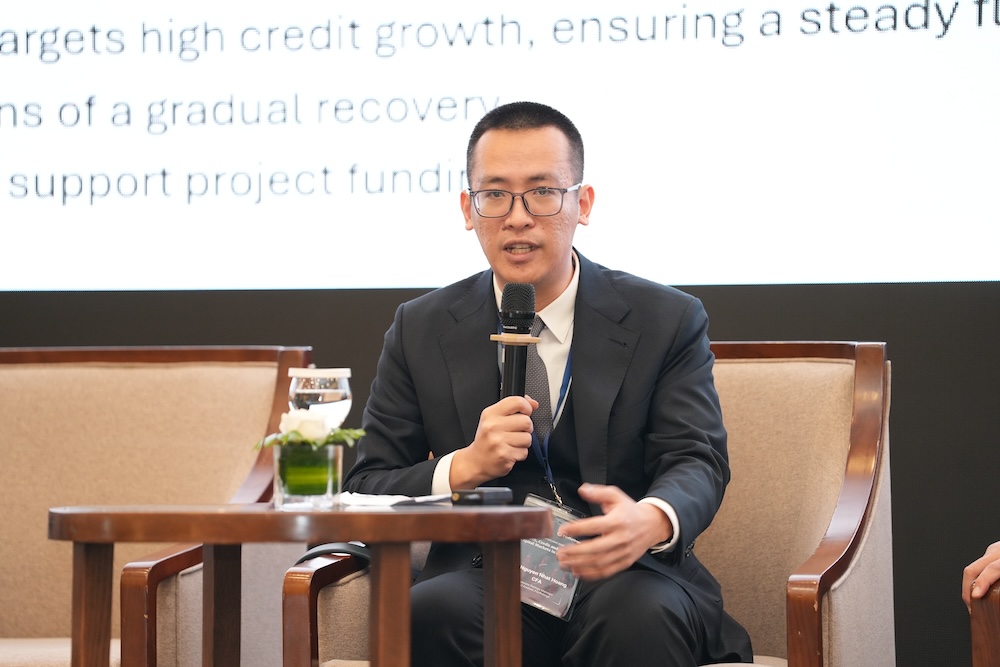With the capital and real estate markets showing signs of recovery and a new growth cycle on the horizon, real estate companies need to sharpen their management skills, diversify their offerings, and build stronger partnerships, both locally and internationally, to stay competitive.

An overview of a panel discussion on the real estate market outlook at the seminar
Regulatory changes fuel real estate market recovery
On February 27, FiinRatings, in partnership with S&P Global Ratings, hosted the Vietnam Credit Focus 2025 seminar, themed “Growth, Credit, and Capital Markets in the New Era.”
Speaking about the real estate sector, Lucas Loh, general manager of Nam Long Group, pointed out that Vietnamese developers have faced significant hurdles, stemming from market supply and demand imbalances and capital market volatility between 2018 and 2023.
Specifically, in the commercial housing segment, legal ambiguities have constrained market supply, impacting both customer access to housing and developer profitability.
However, the second half of 2024 has brought positive signs, with legal reforms and Government efforts to address market challenges. The amended Land Law, Real Estate Business Law, and Housing Law, effective August 1, 2024, are expected to significantly reshape the real estate landscape.
“These new laws are designed to resolve conflicting and overlapping regulations, reducing the risk of inconsistent interpretations across different regions,” said Loh.

Lucas Loh, general manager of Nam Long Group
From a consumer perspective, the general manager of Nam Long Group believes that stricter sales regulations, such as mandatory business licenses and clearer project approval processes, will enhance market transparency. This will empower buyers to easily verify legal status and project progress.
Furthermore, caps on deposit amounts for off-plan purchases (maximum 5% of the selling price) and initial payments (no more than 30% of the contract value, including the deposit) will prevent developers from collecting excessive upfront payments, which may be up to 90-95% of the real estate value.
Given these developments, Loh said that genuine homebuyer demand is rebounding, fueled by increased confidence following the implementation of the new regulations.
Echoing this sentiment, Nguyen Nhat Hoang, senior manager of Non-Financial Corporate Ratings at FiinRatings, observed that the Vietnamese real estate market is stabilizing after a severe downturn. Recently, transaction volumes have started to normalize, and investor and buyer confidence is improving.
“Despite ongoing challenges, the real estate sector is heading towards a more sustainable recovery, as the new legal framework takes effect. This should boost new supply in major cities and satellite areas from 2025 onwards,” Hoang said.
Adding to this, Hoang noted that financing conditions are becoming more favorable, with the State Bank of Vietnam targeting 16% credit growth in 2025, signaling increased liquidity support for the economy, including the real estate sector.
However, access to capital will not be uniform. Developers with strong financial foundations and transparent capital structures will have a clear advantage.

Nguyen Nhat Hoang, senior manager of Non-Financial Corporate Ratings at FiinRatings
Real estate lending shifts towards homebuyers
Delving into real estate credit, Nguyen Nhat Hoang highlighted that recent bond and real estate market fluctuations have dampened investor sentiment.
“Increased caution has slowed credit flow into the sector, particularly for homebuyers,” Hoang said.
Nevertheless, key indicators suggest underlying strength. Despite a 25-30% drop in apartment transactions in recent years, average apartment values have doubled—one of the world’s largest increases—signaling robust demand.
The new legal framework is also a crucial factor. While there are concerns about increased costs, it provides a more solid foundation for developers to assess project viability.
In this context, Hoang predicted that real estate lending would gradually shift towards homebuyers, rather than focusing primarily on developers, as it had in the past.
FiinRatings forecast a stronger recovery in real estate lending in 2025-2026, particularly in satellite cities where supply is abundant, prices are relatively stable, and incomes are growing faster than in major urban centers.
Against this backdrop, Loh emphasized that real estate companies, as market suppliers, must collaborate closely with the Government and regulatory bodies to remove obstacles, improve the investment climate, and foster market growth.
Furthermore, companies need to enhance their management capabilities, diversify their product offerings, and strengthen partnerships to boost competitiveness.
Nam Long Group, for instance, adopts a balanced approach between equity and debt, using both bank loans and capital market funding. It also strategically partners with investors, sharing half of project costs to mitigate risk.
“We have had several Japanese investors partner with us for the past decade, which helps alleviate funding pressures,” Loh noted.
Even amidst challenging market conditions, Nam Long Group successfully issued bonds to raise VND1.8 trillion in 2024. According to Loh, this reflects the company’s focus on prudent capital management to ensure competitiveness in all market cycles, rather than solely focusing on land acquisition, construction, and sales.
“For real estate companies, which often leverage significant debt, the key is to manage finances and cash flow meticulously, positioning themselves to capitalize on emerging opportunities,” Loh stressed.
Hoang Thang
(The Saigon Times)















